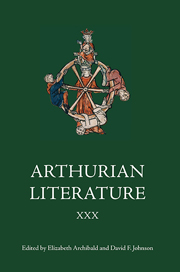Book contents
- Frontmatter
- Contents
- General Editors' Foreword
- List of Contributors
- I Magic and the Supernatural in Early Welsh Arthurian Narrative: Culhwch ac Olwen and Breuddwyd Rhonabwy
- II How Green was the Green Knight? Forest Ecology at Hautdesert
- III Edward III's Arthurian Enthusiasms Revisited: Perceforest in the Context of Philippa of Hainault and the Round Table Feast of 1344
- IV Pagan Gods and the Coming of Christianity in Perceforest
- V Malory's Sources for the Tale of the Sankgreal: Some Overlooked Evidence from the Irish Lorgaireacht an tSoidigh Naomhtha
- VI ‘Transmuer de rime en prose’: The Transformation of Chrétien de Troyes's Joie de la Cour episode in the Burgundian Prose Erec (1450–60)
- VII La Rétro-écriture ou l'écriture de la nostalgie dans le roman arthurien tardif: Ysaïe le Triste, Le Conte du Papegau et Mélyador de Froissart
- VIII Remembering Brutus: Aaron Thompson's British History of 1718
- Contents of Previous Volumes
VI - ‘Transmuer de rime en prose’: The Transformation of Chrétien de Troyes's Joie de la Cour episode in the Burgundian Prose Erec (1450–60)
Published online by Cambridge University Press: 05 March 2014
- Frontmatter
- Contents
- General Editors' Foreword
- List of Contributors
- I Magic and the Supernatural in Early Welsh Arthurian Narrative: Culhwch ac Olwen and Breuddwyd Rhonabwy
- II How Green was the Green Knight? Forest Ecology at Hautdesert
- III Edward III's Arthurian Enthusiasms Revisited: Perceforest in the Context of Philippa of Hainault and the Round Table Feast of 1344
- IV Pagan Gods and the Coming of Christianity in Perceforest
- V Malory's Sources for the Tale of the Sankgreal: Some Overlooked Evidence from the Irish Lorgaireacht an tSoidigh Naomhtha
- VI ‘Transmuer de rime en prose’: The Transformation of Chrétien de Troyes's Joie de la Cour episode in the Burgundian Prose Erec (1450–60)
- VII La Rétro-écriture ou l'écriture de la nostalgie dans le roman arthurien tardif: Ysaïe le Triste, Le Conte du Papegau et Mélyador de Froissart
- VIII Remembering Brutus: Aaron Thompson's British History of 1718
- Contents of Previous Volumes
Summary
In the prologue to the mid-fifteenth-century adaptation of the ‘rhymed story of Erec, the son of King Lac,’ the prosateur describes his work as a ‘transmutation’: ‘… pour ce que l'en m'a presentee le histoire de Erec le filz du roy Lach en rime, je, au plaisir de Dieu, occuperay mon estude ung petit de tamps a le transmuer de rime en prose …’ (Because I have been presented with the rhymed story of Erec, the son of King Lac, I shall, God willing, devote a little time to transposing it from verse into prose …). The term transmuer (to transform or change) suggests the extent of the modifications the adapter performed as he turned Chrétien's poem into prose. Readers of Arthurian romances will be familiar with the techniques the redactor deployed in appropriating Chrétien's text: abbreviation, amplification and rationalization. However, the full compass of the transformations, which occur on a socio-cultural level but more importantly, inform the literary art, may be surprising to them. Indeed, the modifications affect the structure and the meaning of the romance. While the prose text respects the general outline of the story, it abbreviates or omits many elements, but also embroiders, alters and even adds new material. In addition, it changes countless details in such a way that the adaptation is in fact a completely new text.
- Type
- Chapter
- Information
- Arthurian Literature XXX , pp. 101 - 116Publisher: Boydell & BrewerPrint publication year: 2013



